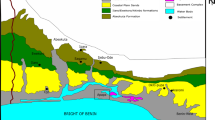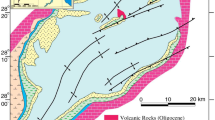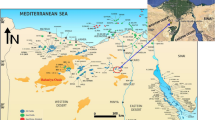Abstract
The present study is carried out in Nubian sandstone aquifer, western bank of River Nile, Aswan area. The data of the two wells (W-1 and W-2), which are located in the area are available. It consists of all geological, hydrogeological, hydrochemical, and geophysical well-logging information. An attempt is made in the present study to estimate hydraulic conductivity using resistivity logs in intent to compare between the estimated and the measured values. Resistivity logs are used to estimate the intrinsic formation factor. Clay effect is removed via application of Waxman–Smits model. Accordingly, total porosity is estimated from the most widely used modified form of Archie equation for clean sand formations (Humble equation). Total porosity and average grain size diameter of Nubian sandstone are applied in the Kozeny-Carman-Bear model to estimate the geometric hydraulic conductivity. The hydraulic conductivity is estimated to be 12.6 ± 1.9 m/day for the Nubian sandstone aquifer in this area, whereas the measured hydraulic conductivity via pumping test in the same well is 10.7 m/day. From the present study, the application of geophysical well logging could provide a cost-effective and efficient alternative to estimate aquifer parameters.





Similar content being viewed by others
References
Alger RP (1966) Interpretation of electric logs in fresh water wells in unconsolidated formations. Soc Prof Well Log Analyst Trans, Art CC, 1–25
Archie GE (1942) The electrical resistivity log as an aid in determining some reservoir characteristics. Transactions of the American Institute of Mining and Metallurgical Engineers/Petroleum Division 146:54–62
Batu V (1998) Aquifer hydraulics; a comprehensive guide to hydrogeologic data analysis. Wiley, New York
Bear J (1972) Dynamics of fluids in porous media. Elsevier, New York
Börner FD, Schopper JR, Weller A (1996) Evaluation of transport and storage properties in the soil and groundwater zone from induced polarization measurements. Geophys Prospect 44:583–601
Carman PC (1937) Fluid flow through granular beds. Trans Inst Chem Eng (Lodon) 15:150466
Carman PC (1956) Flow of gases through porous media. Butterworth, London
Chandra S, Ahmed S, Ram A, Dewandel B (2008) Estimation of hard rock aquifers hydraulic conductivity from geoelectrical measurements: a theoretical development with field application. J Hydrol I. 357(3–4):218–227
Chappelier D (1992) Well logging in hydrogeology. A.A. Balkema Publishers, Lisse, p 175
Chapuis RP, Aubertin M (2003) Predicting the coefficient of permeability of soils using the Kozeny–Carman equation. EPM-RT2003-03. Department CGM, École Polytechnique de Montréal, Canada
Clavier C, Coates G, Dumanoir R (1984) The theoretical and experimental bases for “dual water” model for the interpretation of shaley sands. Soc Petrol Eng J 4:153–168
DASCO (2003) Professional report on drilling of productive well no. (2)-New Aswan city, Aswan (in Arabic). National Egyptian Drilling and Petroleum Services Company
De Lima OA, Sharma MM (1990) A grain conductivity approach to shaly sandstones. Geophysics 55(10):1347–1356
El Shazly EM, Abdel Hady MA, El Kassas IA, El Amin H, Abdel Megid AA, Mansour SI, El Shazly MM, Tamer MA (1977) Geology and Groundwater conditions of Tushka Basin area, Egypt utilizing landsat satellite images. Remote Sensing Center, Academy of Scientific Research and Technology, Cairo
Evans K, Beavan J, Simpson D (1991) Estimating aquifer parameters from analysis of forced fluctuation in well level: an example from the Nubian formation near Aswan, Egypt, 1. Hydrogeological background and large-scale permeability estimates. J Geophys Res 96(B7):12.127–12.137
Farris (1951) in El Shazly EM, Abdel Hady MA, El Kassas IA, El Amin H, Abdel Megid AA, Mansour SI, El Shazly MM, Tamer M, A, 1977. Geology and groundwater conditions of Tushka Basin area, Egypt utilizing landsat satellite images. Remote Sensing Center, Academy of Scientific Research and Technology, Cairo
Geoistrazivanja Company (1965) Supply and installation of 23 piezometers within the High Aswan Dam reservoir area, report to U.A.R. Minist. Of the High Dam, Cairo, 50
Hefny K, Farid S, Hussein M (1992) Groundwater assessment in Egypt. Int J Water Resour Dev 8(2):126–134
Huntley D (1987) Relations between permeability and electrical resistivity in granular aquifers. Groundwater 24(4):466–474
Kozeny J (1927) Ueber Kapillare leitung des wassers in Boden. Sitzungsber Akad Wiss Wein 136(2a):271–306
Martys NS (1999) Diffusion in partially-saturated porous materials. Mater Struct (Materiaux et Constructions) 32:555–562
Mousa S (1991) Hydrology and hydrogeology investigations in the Kalabsha area at Aswan. M.Sc. Thesis, Assiut University, Egypt
Niwas S, Singhal DC (1981) Estimation of aquifer transmissivity from Dar Zarrouk parameters in porous media. J Hydrol 50:393–399
Niwas S, Singhal DC (1985) Aquifer transmissivity of porous media from resistivity data. J Hydrol 82:143–153
Patnode WH, Wyllie MRJ (1950) The presence of conductive solids in reservoir rocks as factor in electric log interpretation. Petroleum Transactions American Institute of Mining, Metallurgical and Petroleum Engineers 189:47–52
Pflannkuch HO (1969) On the correlation of electrical conductivity properties of porous system with viscous flow transport coefficients. In: Proceedings of the IAHR First International symposium on fundamentals of transport phenomena in porous media, Haifa. pp 42–54
Schön JH (1996) Physical properties of rocks—fundamentals and principles of geophysics. In: Helbig K, Treitel S (eds) Handbook of geophysical exploration—seismic exploration, vol 18. Pergamon, London, p 583
Sen PN, Goode PA, Sibbit A (1988) Electrical conduction in clay bearing sandstones at low and high salinities. J Appl Phys 63:4832–4840
Soupios P, Kouli M, Vallianatos F, Vafidis A, Stavroulakis G (2007) Estimation of aquifer hydraulic parameters from surficial geophysical methods: a case study of Keritis basin in Chania (Crete-Greece). J Hydrol (Amst) 338:122–131
Tamer MA (1974) Hydrogeology of A.R.E. and some changes occurring as a result of the construction of hydrotechnologic projects. Ph.D. Thesis, Kiev University (in Russian)
Van Houten FB, Bhattacharyya DP, Manour SET (1984) Cretaceous Nubian Formation and correlative deposits, Eastern Egypt: major regressive-transgressive complex. Gel Soc Ann Bull 95:397–405
Vinegar HJ, Waxman MH (1984) Induced polarization of shaly sands. Geophysics 49(8):1267–1287
Waxman MH, Smits LJM (1968) Electrical conductivities in oil bearing sands. Journal of the Society of Petroleum Engineers 8:107–122
Winsauer WO, McCardell WM (1953) Ionic double-layer conductivity in reservoir rock. Trans Am Inst Min Metall Pet Eng 198:129–134
Winsauer WO, Shearin HM Jr, Masson PH, Williams H (1952) Resistivity of brine saturated sands in relation to pore geometry. Bull AAPG 36(2):253–277
Worthington PF (1993) The uses and abuses of the Archie equations. 1. The formation factor–porosity relationship. J Appl Geophys 30:215–228
Yadav GS, Kumar R, Singh PN, Singh SC (1993) Geoelectrical soundings for aquifer characterization around Jayant colony-singrauli, Sidhi District, MP. J Assoc Expl Geophysists XIV(3):123–131
Acknowledgments
The corresponding author is indebted to the Fundação para a Ciência e Tecnologia (Portugal) for his support through the post-doctoral fellowship (SFRH\BPD\29971/2006). This work was partly developed in the scope of the scientific cooperation agreement between the CGUL and the NRIAG.
Author information
Authors and Affiliations
Corresponding author
Appendix
Rights and permissions
About this article
Cite this article
Khalil, M.A., Santos, F.A.M. Hydraulic conductivity estimation from resistivity logs: a case study in Nubian sandstone aquifer. Arab J Geosci 6, 205–212 (2013). https://doi.org/10.1007/s12517-011-0343-2
Received:
Accepted:
Published:
Issue Date:
DOI: https://doi.org/10.1007/s12517-011-0343-2




